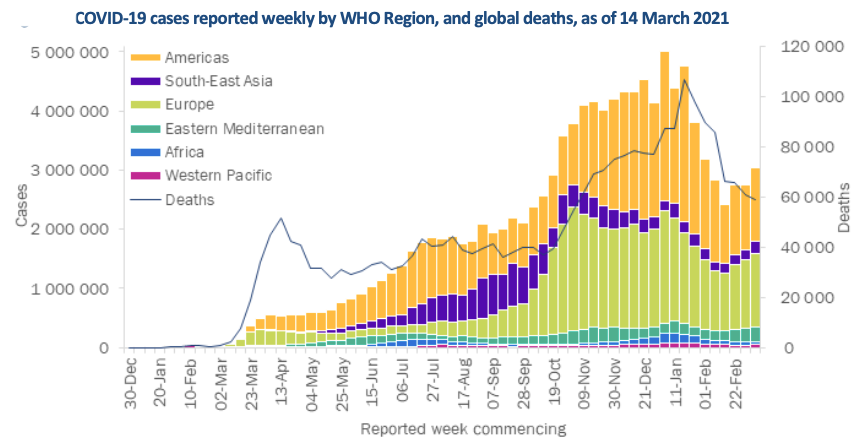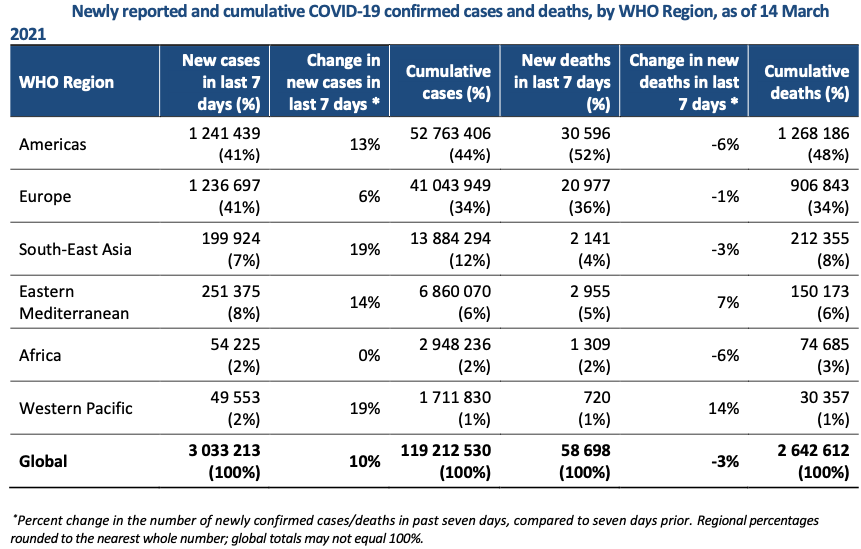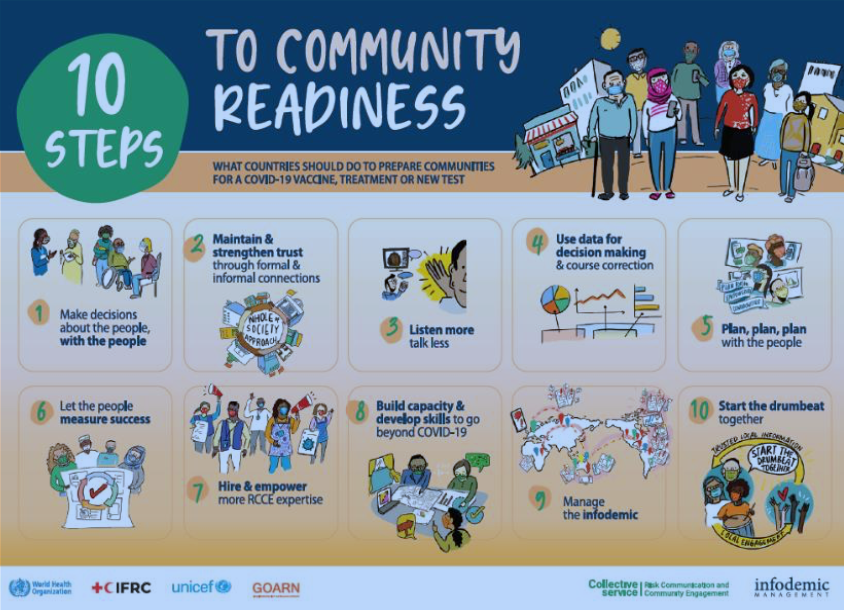
India saw 21% rise in Corona-related deaths last week
Geneva: In the past week new Corona cases continued to rise globally, increasing by 10% in the past week to over 3 million new reported cases, the latest data as received by World Health Organisation from national authorities, as of 14 March 2021, have revealed.
The WHO’s latest COVID-19 Weekly Epidemiological Update released today further pointed out that in the past three weeks new cases had increased again. It recalled that after peaking in early January 2021 when there were just under 5 million cases, new cases had then declined to around 2.5 million in the week commencing 15 February 2021.
This week, the Americas and Europe continued to account for over 80% of new cases and new deaths, with rises in new cases seen in all regions apart from Africa, where they remained the same as last week, the report showed.
Also read: Maharashtra, Punjab, Karnataka, Gujarat and Tamil Nadu continue to drive up new active Corona cases
The highest numbers of new cases were reported from Brazil (494 153 new cases; 20% increase), the United States of America (461 190 new cases; 8% increase), France (161 159 new cases; 12% increase), Italy (155 076 new cases; 12% increase), and India (148 249 new cases; 30% increase).
New deaths on the other hand continued to decline and were now under 60 000, since peaking in the week commencing January 18, 2021, when there were over 95 000 new deaths in the week. The last time when there were fewer than 60 000 new weekly deaths was four months ago, in the week commencing 9 November.
This week, although new deaths declined globally, they rose in two WHO regions; the Eastern Mediterranean and the Western Pacific .
The Eastern Mediterranean region new weekly cases in the region have increased for the past five weeks and deaths have increased for the past three weeks. Last week the region reported over 251 000 new cases and just under 3000 new deaths, a 14% and a 7% increase respectively compared to the previous week. In the region, the highest numbers of new deaths were reported from the Islamic Republic of Iran (630 new deaths; 0.8 new deaths per 100 000; an 18% increase), Jordan (385 new deaths; 3.8 new deaths per 100 000; a 71% increase), and Lebanon (321 new deaths; 4.7 new deaths per 100 000; an 11% decrease). The highest numbers of new cases were reported from the Islamic Republic of Iran (65 890 new cases; 78.4 new cases per 100 000; a 31% increase), Jordan (47 585 new cases; 466.4 new cases per 100 000; a 36% increase), and Iraq (31 129 new cases; 77.4 new cases per 100 000; a 1% increase).
The Western Pacific region reported just under 50 000 new cases and over 700 new deaths, a 19% and a 14% increase respectively compared to the previous week. This was the first time in seven weeks that an increase in new cases had been reported with new deaths also showing an uptick. The highest numbers of new cases were reported from the Philippines (25 473 new cases; 23.2 new cases per 100 000; a 51% increase), Malaysia (10 632 new cases; 32.8 new cases per 100 000; a 21% decrease), and Japan (7917 new cases; 6.3 new cases per 100 000; a 10% increase). The highest numbers of new deaths were reported from Japan (333 new deaths; 0.3 new deaths per 100 000; a 9% decrease), the Philippines (301 new deaths; 0.3 new deaths per 100 000; a 71% increase), and Malaysia (40 new deaths; 0.1 new deaths per 100 000; an 11% decrease).

In WHO’s South-East Asia region, which reported just under 200 000 new cases and just over 2100 new deaths – a 19% increase and a 3% decrease respectively compared to the previous week, the highest numbers of new cases were reported from India (148 249 new cases; 10.7 new cases per 100 000; a 30% increase). These were followed by Indonesia (40 905 new cases; 15.0 new cases per 100 000; a 9% decrease), and Bangladesh (6512 new cases; 4.0 new cases per 100 000; a 67% increase). The highest numbers of new deaths in the region were reported from Indonesia (1175 new deaths; 0.4 new deaths per 100 000; similar to the previous week), India (851 new deaths; 0.1 new deaths per 100 000; a 21% increase), and Bangladesh (76 new deaths; <0.1 new deaths per 100 000; a 49% increase).
The European region reported over 1.2 million new cases and just under 21 000 new deaths, a 6% increase and a 1% decrease respectively compared to the previous week. Cases in the Region have been steadily increasing over the past three weeks while trends in new deaths have been consistently declining for the past eight weeks. The highest numbers of new cases were reported from France (161 159 new cases; 246.9 new cases per 100 000; a 12% increase), Italy (155 076 new cases; 256.5 new cases per 100 000; a 12% increase), and Poland (111 718 new cases; 295.2 new cases per 100 000; a 27% increase). The highest numbers of new deaths were reported from the Russian Federation (2990 new deaths; 2.0 new deaths per 100 000; similar to the previous week), Italy (2303 new deaths; 3.8 new deaths per 100 000; an 11% increase), and Poland (1893 new deaths; 5.0 new deaths per 100 000; a 25% increase).
The region of the Americas reported over 1.2 million new cases and over 30 000 new deaths, a 13% increase and a 6% decrease respectively compared to the previous week. Deaths continued to decrease for the second consecutive week. The highest numbers of new cases were reported from Brazil (494 153 new cases; 232.5 new cases per 100 000; a 20% increase), the United States of America (461 190 new cases; 139.3 new cases per 100 000; an 8% increase), and Peru (52 763 new cases; 160.0 new cases per 100 000; a 58% increase). The highest numbers of new deaths were reported from Brazil (12 335 new deaths; 5.8 new deaths per 100 000; a 24% increase), the United States of America (9381 new deaths; 2.8 new deaths per 100 000; a 24% decrease), and Mexico (4273 new deaths; 3.3 new deaths per 100 000; a 16% decrease). These three countries accounted for 85% of deaths reported in the Americas this week.
The African region reported over 54 000 new cases, a number similar to last week, while deaths decreased by 6% compared to the previous week with just over 1300 deaths reported. The decreasing trend in deaths has been observed since early February 2021. The highest numbers of new cases were reported from Ethiopia (9025 new cases; 7.9 new cases per 100 000 population; a 29% increase), South Africa (8208 new cases; 13.8 new cases per 100 000; a 3% increase), and Kenya (5476 new cases; 10.2 new cases per 100 000; a 226% increase). The highest numbers of new deaths were reported from South Africa (614 new deaths; 1.0 new deaths per 100 000 population; a 13% decrease), Ethiopia (120 new deaths; 0.1 new deaths per 100 000; an 82% increase), and Botswana (65 new deaths; 2.8 new deaths per 100 000; a 33% increase).
Meanwhile, the WHO stated that in the next critical phase of the response, when vaccines and other biomedical tools become more widely available, building trust and engaging communities was essential.
“People have concerns over the safety of vaccines and other biomedical tools made with unprecedented speed and with new technologies,” the WHO stated while asserting that these concerns must be acknowledged and addressed by providing individuals and communities with actionable, timely and credible health information from trusted sources and by providing the space and follow-up necessary to work through these concerns with trusted health or community leaders.
It referred to recent studies that suggest that around 65% of global populations surveyed are willing to be vaccinated with a COVID-19 vaccine. “But this has fluctuated over time. The proportion of those likely to accept a COVID-19 vaccine varies significantly between regions and countries and within countries,” it stated.
One of the ways WHO is supporting countries strengthen their engagement and empowerment strategies is through the publication of the 10 Steps to Community Readiness – What countries should do to prepare communities for a COVID-19 vaccine, treatment, or new test.
10 Steps to Community Readiness

10 Steps to Community Readiness is a new tool, developed by WHO, UNICEF, IFRC and the Global Outbreak and Alert Response Network (GOARN) through the Risk Communication and Community Engagement (RCCE) Collective Service (a new partnership launched in June 2020), to strengthen coordination and quality of practice for the COVID-19 pandemic response.
The tool is built around the recognition that the empowerment of people and communities is not an abstract idea, and there are concrete and measurable steps that can be taken to ensure citizens are engaged and ready to support new biomedical tools, the WHO claimed.
– global bihari bureau





